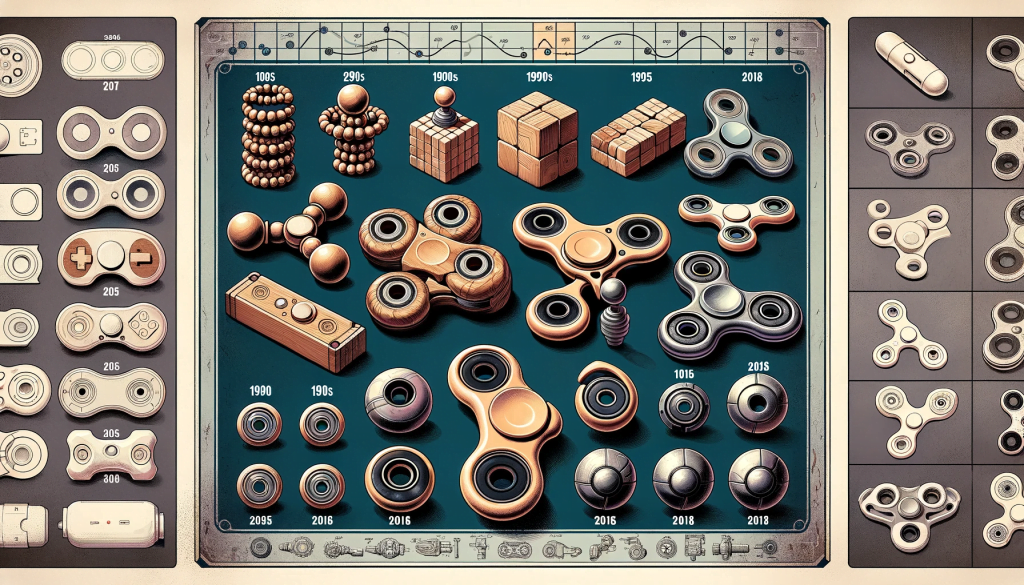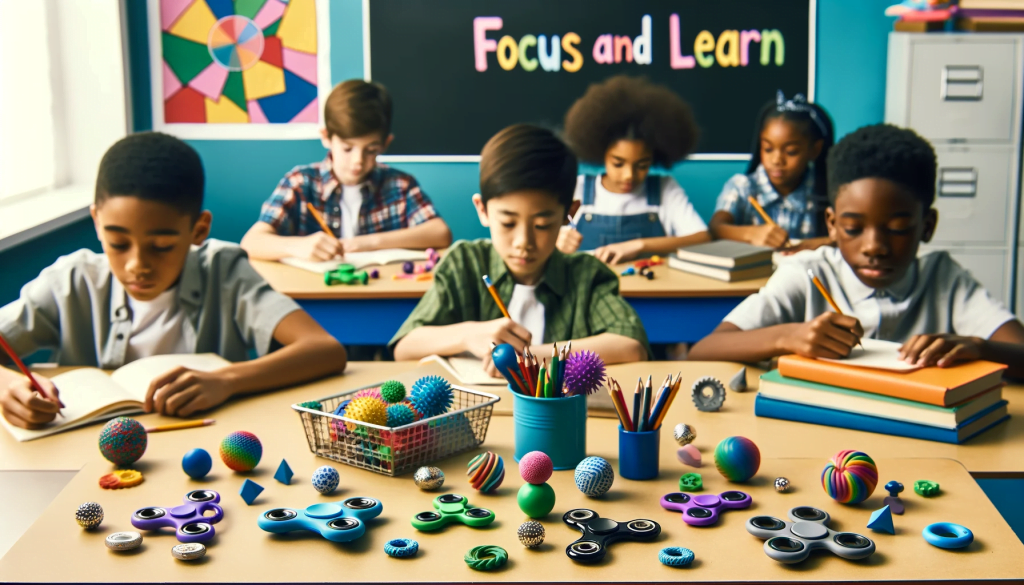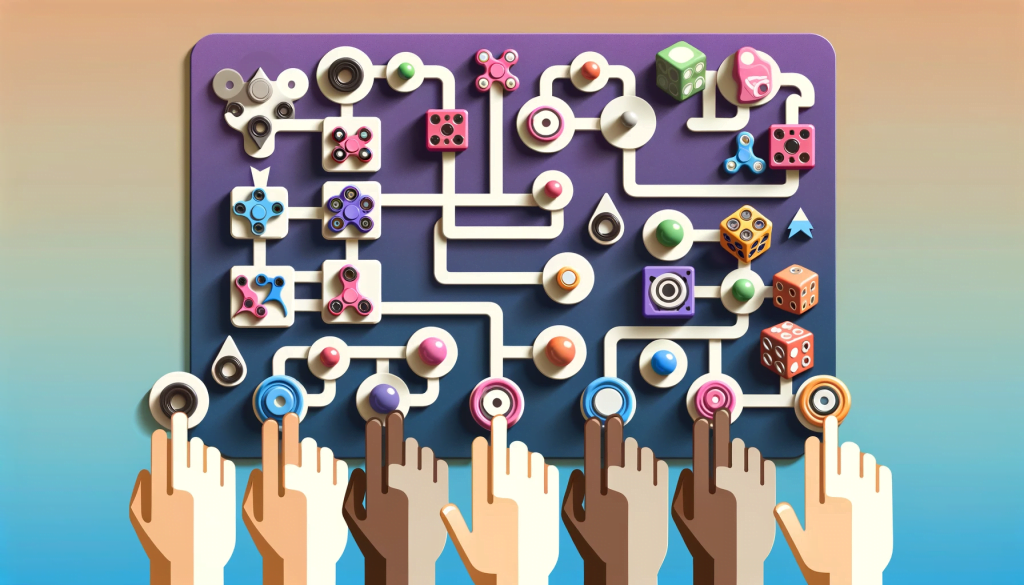Introduction
Fidget toys have taken the world by storm in recent years, gaining popularity not only among children but also adults. These seemingly simple gadgets, designed for fidgeting and sensory stimulation, have become much more than just playthings. They are now recognized for their remarkable benefits, especially when it comes to enhancing concentration and focus. In this blog post, we’ll explore the top 5 amazing perks of fidget toys for stellar concentration. Whether you’re a student looking to improve your studying efficiency or a professional aiming to boost productivity, you’ll discover how these unassuming gadgets can make a significant difference in your ability to stay focused and perform at your best.
The Rise of Fidget Toys in Popular Culture
To understand the impact of fidget toys on concentration, it’s important to recognize how they’ve permeated popular culture. What began as a simple tool to help individuals manage anxiety and restlessness has evolved into a global phenomenon. From spinners and cubes to stress balls and more, fidget toys come in various shapes and sizes, catering to a wide range of preferences. They’ve not only gained traction in classrooms and workplaces but have also become collectible items, with enthusiasts constantly seeking the latest designs. As these toys continue to captivate the minds of people worldwide, it’s clear that their relevance extends beyond mere novelty. We’ll delve into the science behind their effectiveness and explore why they’re much more than just trendy gadgets.
Overview of the Blog Post Content
In this blog post, we’ll delve into five key perks of using fidget toys to enhance concentration. We’ll explore the psychological and physiological mechanisms that make these gadgets effective tools for improving focus. Our discussion will cover the following topics:
1. Stress Reduction: How fidget toys can help alleviate stress and anxiety, ultimately creating a more conducive environment for concentration.
2. Sensory Stimulation: The role of sensory input in maintaining attention, and how fidget toys provide a constant but non-distracting source of sensory engagement.
3. Improved Cognitive Performance: How fidgeting can actually enhance cognitive functions like memory and problem-solving, leading to better academic and professional outcomes.
4. Enhanced Learning: The application of fidget toys in educational settings, including how they can assist students in absorbing information more effectively.
5. Workplace Productivity: How fidget toys can contribute to increased productivity and creativity in the workplace, making them valuable tools for professionals.
By the end of this blog post, you’ll have a comprehensive understanding of why fidget toys have become essential aids for achieving stellar concentration in various aspects of life.
History and Evolution of Fidget Toys

From Stress Balls to Spinners: The Timeline
The history of fidget toys dates back several decades, with the earliest predecessors primarily focusing on stress relief. Stress balls, for instance, were among the first fidget-like objects designed to provide individuals with a means to release tension and anxiety. These pliable, hand-sized balls were commonly made of foam or gel and could be squeezed repeatedly, offering a simple yet effective way to alleviate stress.
However, it wasn’t until the early 2010s that the concept of fidget toys truly exploded into popular culture. The introduction of fidget spinners marked a turning point. These small, palm-sized devices featured a central bearing that allowed them to spin effortlessly between the fingers. Fidget spinners quickly became a global sensation, with people of all ages embracing them as tools for relaxation and concentration. While spinners experienced a meteoric rise in popularity, they were just the beginning of a broader trend. Today, fidget toys encompass an extensive range of designs and materials, catering to diverse preferences and sensory needs.
The Science Behind the Spin: How Fidget Toys Work
The effectiveness of fidget toys in promoting concentration and reducing anxiety can be attributed to several underlying scientific principles. One key aspect is the concept of sensory stimulation. Fidget toys provide a consistent source of tactile and kinesthetic feedback. When individuals engage with these toys, whether by squeezing a stress ball or spinning a spinner, their brains receive sensory signals that help redirect restless energy. This sensory input can be calming and soothing, helping individuals achieve a state of heightened focus.
Furthermore, fidget toys can serve as a distraction buffer. For individuals with attention difficulties, such as those with ADHD, having a discreet and non-disruptive outlet for fidgeting can prevent more distracting behaviors, like tapping a pen or bouncing a leg. By allowing individuals to engage in subtle, repetitive movements, fidget toys help maintain a baseline level of alertness and engagement without causing disruptions in classrooms or workplaces.
In summary, the history and evolution of fidget toys reveal how these simple gadgets have evolved from stress-relief tools like stress balls to more specialized and diverse devices like fidget spinners. The science behind fidget toys underscores their efficacy in providing sensory stimulation and distraction buffering, ultimately contributing to improved concentration and reduced stress and anxiety. These principles have made fidget toys an integral part of many individuals’ lives, helping them achieve greater focus and well-being.
The Psychological Advantages of Fidgeting
Channeling Restlessness Positively
Fidgeting, often viewed as a sign of restlessness or inattentiveness, actually has psychological advantages when channeled positively. It’s a natural response to situations that require prolonged attention, such as listening to a lecture or working on a complex task. Fidgeting provides an outlet for excess energy and helps individuals regulate their focus. Rather than attempting to suppress the urge to fidget, which can lead to increased discomfort and distraction, allowing controlled fidgeting can be beneficial.
When individuals engage in purposeful fidgeting, like using fidget toys, they are better able to manage restlessness. This positive channeling of energy can help reduce feelings of restlessness and improve overall comfort during tasks that require sustained attention. It’s akin to giving the mind a release valve, allowing individuals to redirect their restlessness in a way that doesn’t disrupt their concentration or the activities at hand.
Impact on Concentration and Memory
Fidgeting, when done in a controlled and purposeful manner, can have a profound impact on concentration and memory. Studies have shown that mild physical activity, such as tapping a foot or lightly squeezing a stress ball, can stimulate the release of neurotransmitters like dopamine and norepinephrine. These neurotransmitters are associated with improved mood, alertness, and cognitive function.
Engaging in subtle fidgeting movements can help individuals stay more alert and focused during tasks that require sustained attention. It can also enhance their working memory, allowing them to retain and manipulate information more effectively. In classroom settings, for example, students who are allowed to fidget in a non-disruptive way often perform better on tasks that demand concentration and recall.
Moreover, fidgeting can help mitigate the negative effects of mental fatigue. When engaged in a cognitively demanding task for an extended period, individuals may experience a decline in attention and productivity. Fidgeting can counteract this decline by providing periodic sensory stimulation, helping individuals stay engaged and alert.
In conclusion, understanding the psychological advantages of fidgeting highlights its role in improving concentration and memory. By allowing individuals to channel their restlessness positively, fidgeting can enhance focus, working memory, and overall cognitive performance. This insight underscores the value of fidget toys and other purposeful fidgeting techniques as tools for achieving stellar concentration and cognitive functioning.
Fidget Toys in Learning Environments

Enhancing Attention in Classrooms
The use of fidget toys in classrooms has gained significant recognition for their potential to enhance attention and concentration among students. Traditional classroom settings often require students to sit for extended periods, which can be challenging, especially for those who struggle with restlessness or attention issues. Fidget toys provide an effective outlet for excess energy, allowing students to engage in subtle, non-disruptive movements that can help them maintain focus.
By allowing students to use fidget toys during lessons, educators have reported noticeable improvements in student engagement and participation. These toys can serve as a tool for self-regulation, enabling students to redirect their restlessness in a way that doesn’t disrupt the learning environment. The tactile and kinesthetic feedback provided by fidget toys can have a calming effect, making it easier for students to absorb and retain information.
Moreover, fidget toys can be particularly beneficial during activities that require passive listening, such as lectures or reading assignments. They help students stay alert and attentive, reducing the likelihood of drifting into daydreaming or distraction. When used appropriately, fidget toys can contribute to a more conducive and inclusive learning environment, benefiting students of all backgrounds and abilities.
Fidget Toys as Educational Aids for Special Needs
Fidget toys also play a crucial role as educational aids for students with special needs, including those with conditions like attention deficit hyperactivity disorder (ADHD) or autism spectrum disorder (ASD). These students often experience challenges in maintaining attention and managing sensory sensitivities. Fidget toys are particularly valuable for them as they offer a means to address these challenges.
For students with ADHD, fidget toys can provide a constructive outlet for their hyperactivity and restlessness. These toys allow them to channel their excess energy in a way that doesn’t disrupt the classroom. In fact, some research suggests that students with ADHD may actually benefit more from fidgeting, as it can help them focus and concentrate better.
In the case of students with ASD, fidget toys can help manage sensory sensitivities and reduce anxiety. Many individuals with ASD find comfort in repetitive sensory experiences, and fidget toys provide a controlled and socially acceptable way to meet these sensory needs. By offering a familiar and soothing sensation, these toys can help students with ASD feel more at ease in the learning environment, thereby promoting better participation and learning outcomes.
In summary, fidget toys have proven to be valuable tools for enhancing attention and improving the learning experience in various educational settings. They offer benefits not only for typically developing students but also for those with special needs, contributing to more inclusive and effective learning environments.
Workplace Wellness: Fidget Toys at Work

Alleviating Workplace Stress
The modern workplace can be a high-stress environment, with constant deadlines, demanding tasks, and the pressure to perform at one’s best. In this context, fidget toys can play a significant role in alleviating workplace stress. Stress often leads to tension, anxiety, and decreased focus, all of which can hinder productivity and overall well-being.
Fidget toys offer employees a discreet and non-disruptive way to manage stress during the workday. Squeezing a stress ball, for example, can help release pent-up tension and reduce anxiety. The repetitive and rhythmic motions of using fidget toys can have a calming effect, promoting relaxation and reducing the physiological markers of stress, such as increased heart rate and elevated cortisol levels.
Additionally, fidget toys can serve as a healthy alternative to less constructive stress-relief methods, such as excessive coffee consumption, nail-biting, or excessive phone scrolling. By providing a more constructive way to manage stress, these toys contribute to a healthier and more balanced work environment.
Boosting Productivity and Creativity
Fidget toys also have the potential to boost productivity and creativity in the workplace. Many professionals find that having a fidget toy within reach can help them stay focused and engaged during tasks that require sustained attention. These toys offer a form of subtle sensory stimulation that can prevent the mind from wandering and help maintain mental alertness.
Moreover, the act of fidgeting has been linked to enhanced creativity and problem-solving abilities. When individuals engage in light fidgeting while brainstorming or working on complex problems, it can stimulate divergent thinking and innovative ideas. Fidgeting can help break mental blocks and foster a more open and creative mindset.
In creative industries, such as design and advertising, some professionals intentionally incorporate fidget toys into their workspaces to encourage creative thinking. They view fidget toys as tools that not only reduce stress but also promote a more conducive environment for generating fresh ideas and solutions.
In conclusion, the use of fidget toys in the workplace can contribute to overall workplace wellness by alleviating stress and boosting productivity and creativity. These unassuming gadgets provide a practical and unobtrusive means for employees to manage stress and maintain focus, ultimately leading to a more positive and productive work environment.
Choosing the Right Fidget Toy

Different Types for Different Needs
When it comes to selecting the right fidget toy, it’s essential to recognize that different types cater to different needs. Fidget toys come in a wide variety of shapes, sizes, and designs, and what works best for one person may not be suitable for another. Here are some factors to consider when choosing the right fidget toy:
- Purpose: Determine your primary goal for using a fidget toy. Are you seeking stress relief, improved concentration, or sensory stimulation? Different types of fidget toys are better suited for specific purposes.
- Sensory Preferences: Consider your sensory preferences. Some people may prefer tactile sensations, such as squeezing or stretching, while others may benefit more from visual or auditory stimulation, like spinners or clicky toys.
- Discretion: Think about where and when you plan to use your fidget toy. If you need a discreet option for meetings or classrooms, you might opt for a quiet, pocket-sized fidget toy.
- Comfort: Consider the ergonomics and comfort of the toy. You should be able to use it comfortably for extended periods without causing discomfort or strain.
- Safety: Ensure that the fidget toy is safe and suitable for your age group. Some fidget toys may have small parts that can pose a choking hazard for young children.
The Sensory Aspect: Texture and Movement
The sensory aspect of a fidget toy is a crucial factor in its effectiveness. Texture and movement are two key sensory elements to consider when choosing the right fidget toy:
- Texture: Fidget toys come in a range of textures, from smooth and squishy to rough and bumpy. The texture can provide tactile stimulation, and individuals may have preferences for specific textures that feel most satisfying to them. Experiment with different textures to find one that you find most soothing or engaging.
- Movement: The type of movement a fidget toy offers can also be significant. Some toys spin, roll, or twist, while others provide resistance to squeezing or stretching. The type of movement can influence how the toy engages your senses and helps you focus or relax. Think about whether you prefer toys that move continuously or those that provide resistance and require more effort.
Ultimately, the right fidget toy is a personal choice based on your specific needs and sensory preferences. It may take some experimentation to find the perfect fidget toy that helps you achieve your desired outcomes, whether that’s stress relief, improved concentration, or sensory stimulation. Remember that what works for one person may not work for another, so don’t hesitate to try different options until you discover the fidget toy that suits you best.
Conclusion
In conclusion, fidget toys have transcended their humble beginnings as stress relievers and become versatile tools with a wide range of applications. From classrooms to workplaces, these unassuming gadgets offer a host of benefits for individuals seeking improved concentration, stress management, and sensory stimulation.
The history and evolution of fidget toys highlight their adaptability and enduring appeal, evolving from simple stress balls to innovative spinners and a diverse array of designs. The science behind fidgeting underscores its positive impact on concentration and cognitive performance, providing valuable insights into the psychology of focus and attention.
In learning environments, fidget toys have proven to be valuable assets, enhancing attention and providing essential support for students with special needs. Their role in promoting inclusion and creating more conducive learning environments cannot be overstated.
Likewise, in the workplace, fidget toys contribute to employee well-being by alleviating stress and boosting productivity and creativity. Their discreet and non-disruptive nature makes them a practical choice for professionals seeking to maintain focus and reduce workplace tension.
When it comes to choosing the right fidget toy, individuals should consider their unique needs, sensory preferences, and the specific purpose for which they intend to use the toy. The texture and movement of the toy play a crucial role in its effectiveness, and finding the perfect fit may require some exploration.
In a world where distractions abound and the demands of modern life can be overwhelming, fidget toys offer a simple yet powerful solution for achieving stellar concentration, reducing stress, and promoting well-being. As we continue to navigate the challenges of our fast-paced society, these unassuming gadgets will likely remain valuable tools on our journey toward improved focus and mental clarity.
If you found this blog post engaging and informative, we invite you to take the next step in your journey by checking our product reviews here. By doing so, you’ll discover a treasure trove of reviews about products similar to the one discussed in this post. These reviews can provide you with valuable insights, user experiences, and expert opinions to help you make informed decisions about your next purchase.












